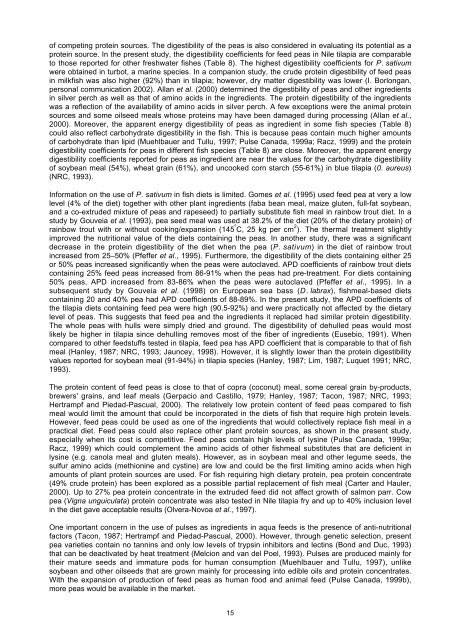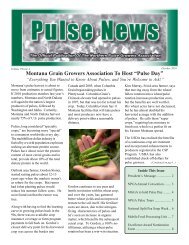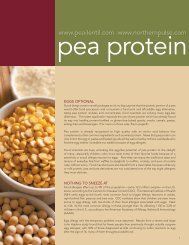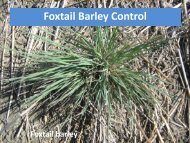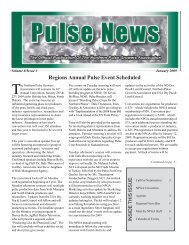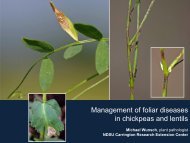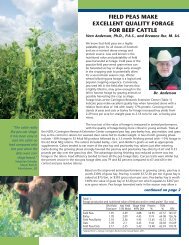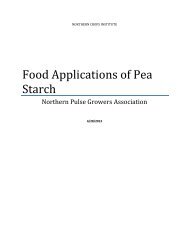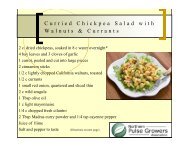Feed Peas in diets for shrimp tilapia and milkfish - Northern Pulse ...
Feed Peas in diets for shrimp tilapia and milkfish - Northern Pulse ...
Feed Peas in diets for shrimp tilapia and milkfish - Northern Pulse ...
You also want an ePaper? Increase the reach of your titles
YUMPU automatically turns print PDFs into web optimized ePapers that Google loves.
of compet<strong>in</strong>g prote<strong>in</strong> sources. The digestibility of the peas is also considered <strong>in</strong> evaluat<strong>in</strong>g its potential as aprote<strong>in</strong> source. In the present study, the digestibility coefficients <strong>for</strong> feed peas <strong>in</strong> Nile <strong>tilapia</strong> are comparableto those reported <strong>for</strong> other freshwater fishes (Table 8). The highest digestibility coefficients <strong>for</strong> P. sativumwere obta<strong>in</strong>ed <strong>in</strong> turbot, a mar<strong>in</strong>e species. In a companion study, the crude prote<strong>in</strong> digestibility of feed peas<strong>in</strong> <strong>milkfish</strong> was also higher (92%) than <strong>in</strong> <strong>tilapia</strong>; however, dry matter digestibility was lower (I. Borlongan,personal communication 2002). Allan et al. (2000) determ<strong>in</strong>ed the digestibility of peas <strong>and</strong> other <strong>in</strong>gredients<strong>in</strong> silver perch as well as that of am<strong>in</strong>o acids <strong>in</strong> the <strong>in</strong>gredients. The prote<strong>in</strong> digestibility of the <strong>in</strong>gredientswas a reflection of the availability of am<strong>in</strong>o acids <strong>in</strong> silver perch. A few exceptions were the animal prote<strong>in</strong>sources <strong>and</strong> some oilseed meals whose prote<strong>in</strong>s may have been damaged dur<strong>in</strong>g process<strong>in</strong>g (Allan et al.,2000). Moreover, the apparent energy digestibility of peas as <strong>in</strong>gredient <strong>in</strong> some fish species (Table 8)could also reflect carbohydrate digestibility <strong>in</strong> the fish. This is because peas conta<strong>in</strong> much higher amountsof carbohydrate than lipid (Muehlbauer <strong>and</strong> Tullu, 1997; <strong>Pulse</strong> Canada, 1999a; Racz, 1999) <strong>and</strong> the prote<strong>in</strong>digestibility coefficients <strong>for</strong> peas <strong>in</strong> different fish species (Table 8) are close. Moreover, the apparent energydigestibility coefficients reported <strong>for</strong> peas as <strong>in</strong>gredient are near the values <strong>for</strong> the carbohydrate digestibilityof soybean meal (54%), wheat gra<strong>in</strong> (61%), <strong>and</strong> uncooked corn starch (55-61%) <strong>in</strong> blue <strong>tilapia</strong> (0. aureus)(NRC, 1993).In<strong>for</strong>mation on the use of P. sativum <strong>in</strong> fish <strong>diets</strong> is limited. Gomes et al. (1995) used feed pea at very a lowlevel (4% of the diet) together with other plant <strong>in</strong>gredients (faba bean meal, maize gluten, full-fat soybean,<strong>and</strong> a co-extruded mixture of peas <strong>and</strong> rapeseed) to partially substitute fish meal <strong>in</strong> ra<strong>in</strong>bow trout diet. In astudy by Gouveia et al. (1993), pea seed meal was used at 38.2% of the diet (20% of the dietary prote<strong>in</strong>) ofra<strong>in</strong>bow trout with or without cook<strong>in</strong>g/expansion (145 º C, 25 kg per cm 2 ). The thermal treatment slightlyimproved the nutritional value of the <strong>diets</strong> conta<strong>in</strong><strong>in</strong>g the peas. In another study, there was a significantdecrease <strong>in</strong> the prote<strong>in</strong> digestibility of the diet when the pea (P. sativum) <strong>in</strong> the diet of ra<strong>in</strong>bow trout<strong>in</strong>creased from 25–50% (Pfeffer et al., 1995). Furthermore, the digestibility of the <strong>diets</strong> conta<strong>in</strong><strong>in</strong>g either 25or 50% peas <strong>in</strong>creased significantly when the peas were autoclaved. APD coefficients of ra<strong>in</strong>bow trout <strong>diets</strong>conta<strong>in</strong><strong>in</strong>g 25% feed peas <strong>in</strong>creased from 86-91% when the peas had pre-treatment. For <strong>diets</strong> conta<strong>in</strong><strong>in</strong>g50% peas, APD <strong>in</strong>creased from 83-86% when the peas were autoclaved (Pfeffer et al., 1995). In asubsequent study by Gouveia et al. (1998) on European sea bass (D. labrax), fishmeal-based <strong>diets</strong>conta<strong>in</strong><strong>in</strong>g 20 <strong>and</strong> 40% pea had APD coefficients of 88-89%. In the present study, the APD coefficients ofthe <strong>tilapia</strong> <strong>diets</strong> conta<strong>in</strong><strong>in</strong>g feed pea were high (90.5-92%) <strong>and</strong> were practically not affected by the dietarylevel of peas. This suggests that feed pea <strong>and</strong> the <strong>in</strong>gredients it replaced had similar prote<strong>in</strong> digestibility.The whole peas with hulls were simply dried <strong>and</strong> ground. The digestibility of dehulled peas would mostlikely be higher <strong>in</strong> <strong>tilapia</strong> s<strong>in</strong>ce dehull<strong>in</strong>g removes most of the fiber of <strong>in</strong>gredients (Eusebio, 1991). Whencompared to other feedstuffs tested <strong>in</strong> <strong>tilapia</strong>, feed pea has APD coefficient that is comparable to that of fishmeal (Hanley, 1987; NRC, 1993; Jauncey, 1998). However, it is slightly lower than the prote<strong>in</strong> digestibilityvalues reported <strong>for</strong> soybean meal (91-94%) <strong>in</strong> <strong>tilapia</strong> species (Hanley, 1987; Lim, 1987; Luquet 1991; NRC,1993).The prote<strong>in</strong> content of feed peas is close to that of copra (coconut) meal, some cereal gra<strong>in</strong> by-products,brewers' gra<strong>in</strong>s, <strong>and</strong> leaf meals (Gerpacio <strong>and</strong> Castillo, 1979; Hanley, 1987; Tacon, 1987; NRC, 1993;Hertrampf <strong>and</strong> Piedad-Pascual, 2000). The relatively low prote<strong>in</strong> content of feed peas compared to fishmeal would limit the amount that could be <strong>in</strong>corporated <strong>in</strong> the <strong>diets</strong> of fish that require high prote<strong>in</strong> levels.However, feed peas could be used as one of the <strong>in</strong>gredients that would collectively replace fish meal <strong>in</strong> apractical diet. <strong>Feed</strong> peas could also replace other plant prote<strong>in</strong> sources, as shown <strong>in</strong> the present study,especially when its cost is competitive. <strong>Feed</strong> peas conta<strong>in</strong> high levels of lys<strong>in</strong>e (<strong>Pulse</strong> Canada, 1999a;Racz, 1999) which could complement the am<strong>in</strong>o acids of other fishmeal substitutes that are deficient <strong>in</strong>lys<strong>in</strong>e (e.g. canola meal <strong>and</strong> gluten meals). However, as <strong>in</strong> soybean meal <strong>and</strong> other legume seeds, thesulfur am<strong>in</strong>o acids (methion<strong>in</strong>e <strong>and</strong> cyst<strong>in</strong>e) are low <strong>and</strong> could be the first limit<strong>in</strong>g am<strong>in</strong>o acids when highamounts of plant prote<strong>in</strong> sources are used. For fish requir<strong>in</strong>g high dietary prote<strong>in</strong>, pea prote<strong>in</strong> concentrate(49% crude prote<strong>in</strong>) has been explored as a possible partial replacement of fish meal (Carter <strong>and</strong> Hauler,2000). Up to 27% pea prote<strong>in</strong> concentrate <strong>in</strong> the extruded feed did not affect growth of salmon parr. Cowpea (Vigna unguiculata) prote<strong>in</strong> concentrate was also tested <strong>in</strong> Nile <strong>tilapia</strong> fry <strong>and</strong> up to 40% <strong>in</strong>clusion level<strong>in</strong> the diet gave acceptable results (Olvera-Novoa et al., 1997).One important concern <strong>in</strong> the use of pulses as <strong>in</strong>gredients <strong>in</strong> aqua feeds is the presence of anti-nutritionalfactors (Tacon, 1987; Hertrampf <strong>and</strong> Piedad-Pascual, 2000). However, through genetic selection, presentpea varieties conta<strong>in</strong> no tann<strong>in</strong>s <strong>and</strong> only low levels of tryps<strong>in</strong> <strong>in</strong>hibitors <strong>and</strong> lect<strong>in</strong>s (Bond <strong>and</strong> Duc, 1993)that can be deactivated by heat treatment (Melcion <strong>and</strong> van del Poel, 1993). <strong>Pulse</strong>s are produced ma<strong>in</strong>ly <strong>for</strong>their mature seeds <strong>and</strong> immature pods <strong>for</strong> human consumption (Muehlbauer <strong>and</strong> Tullu, 1997), unlikesoybean <strong>and</strong> other oilseeds that are grown ma<strong>in</strong>ly <strong>for</strong> process<strong>in</strong>g <strong>in</strong>to edible oils <strong>and</strong> prote<strong>in</strong> concentrates.With the expansion of production of feed peas as human food <strong>and</strong> animal feed (<strong>Pulse</strong> Canada, 1999b),more peas would be available <strong>in</strong> the market.15


